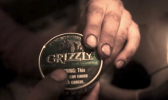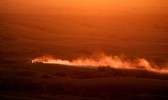This report aired Sept. 11, 2013 on Prairie Public. It’s part three of a four-part series on injuries and deaths in North Dakota’s oil patch. Todd Melby was the reporter.
Made possible by a grant from the Fund for Investigative Journalism.
I’m at a pizza place in Laurel, a small town just west of Billings.
Lacey Breding is at a booth with her daughter and a friend. Outside, the sun is mercilessly hot so everyone is wearing shorts.
“Whatcha doing, monkey?” says Lacey Breding.
That’s Lacey. She’s watching McKinley, her toddler, fuss with the salt and pepper shakers.
For about a year, Lacey dated a man who worked in North Dakota’s oil fields. They met at a rodeo. She was just there because she had nothing else to do. And then she saw a cute guy with unruly brown hair tucked under his cowboy hat. “I knew his friends, but I’d never had seen him before,” Breding says.
His name was Dustin Bergsing. The pair started talking, then flirting, then talking some more. Lacey says for the two days of that rodeo, they got to know each other pretty well. “It was like we’d known each other forever,” she says. “I remember going home and texting my little brother and saying, ‘I met this guy tonight and I’m going to marry him someday.’”
Shortly after they started dating, Lacey got pregnant. When McKinley was born, Dustin took the lead. “As soon as she was born, I was terrified of her,” she says. “I didn’t know what to do. And he just stepped right in and took over changing diapers. Taught me how to swaddle her. He just stepped right up like he knew what he was doing.”
Lacey and Dustin, who were both just a couple years out of high school, made plans to spend the rest of their lives together. Dustin landed an oil field job that paid about $60,000 a year. They planned to marry. They planned to buy a house. They planned to open a business together.
Then on one cold January night last year, Dustin reported for work as a well watcher, He worked alone, monitoring fluid levels on giant tanks near Mandaree. He spent most of his time in a trailer. But every two hours, he climbed a ladder, walked across a catwalk and opened the hatches on multiple storage tanks containing oil, frac water and gases. Sometime around midnight, a co-worker called Dustin. When he didn’t respond, the worker drove to the site and found his lifeless body on a catwalk.
Doctors say he died of “hydrocarbon poisoning due to the inhalation of petroleum vapor.”
He was 21.
“Ahhh, he was beautiful,” Breding says. “He was a beautiful man. He had brown hair. And it was always kinda shaggy, curly like my daughter’s. She has his curls. He had the cutest grin. You could not be mad at him if he had a smile on his face. And his face would turn beat red when he would laugh. I could just see it.”
It’s been more than a year and half since Dustin died. “I have people all the time asking me if I’ve started dating yet or if I’ve found somebody else,” she says. “It drives me crazy because I am so madly in love with that kid. Even now. I don’t know if I’ll ever be able to.”
Says her friend Jason Bold, “She might sound like a broken record, but that’s her favorite record.” He’s wearing a tan cowboy hat and eating cheese sticks. He and his girlfriend used to hang out with Lacey and Dustin.
“He was just so awesome fun to be around all the time,” Bold says. “I mean, you can be around some people and after a day or two, you get sick and tired and bored of them. No. I want to be around you all day, every day. You crack me up. You make me giggle. He was so fun. Just thinking about him.”
After Dustin died, Jason was so upset to see Lacey alone with her daughter that he organized the Dustin Bergsing Memorial Bull Ride. The event was held at Miller’s Horse Palace near Laurel. “We had damn near 300 people show up at the horse palace, which is the largest, biggest event the horse palace ever had,: Bold says.
The bull ride raised several thousand dollars for Lacey and baby McKinley, so Jason lassoed a bunch of volunteers, offered up some prize money and put on the bull ride again this year. Another thing about Jason …
He used to work on drilling rigs in the Bakken. He didn’t like it. “They just care about that little green dollar,” Bold says. “That’s all they care about. They don’t care about who you are or where you’re from. All they care about is you get to work, you bust your ass, and we want to hit TD. You know, total depth or bottom hole. We want to hit oil and move on to the next hole.”
After Dustin died, his mother sued Marathon Oil. They own the well where Dustin died. The case was settled out of court for an undisclosed sum of money. As is typical in cases like these, Dustin’s mother and his fiancée, Lacey Breding, can’t discuss the details.
So they go on living.
Lacey carries around a soft cover photo album for McKinley. Inside are photos of a father McKinley will never see again.
More stories from the series are here:
















